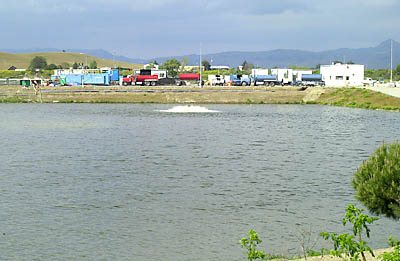
Hollister’s sweeping three-year wastewater plan may soon broaden
in complexity, as officials in recent months have discussed the
possibility of decreasing the proposed size of the sewer plant and
adding a smaller satellite facility to the project.
Hollister’s sweeping three-year wastewater plan may soon broaden in complexity, as officials in recent months have discussed the possibility of decreasing the proposed size of the sewer plant and adding a smaller satellite facility to the project.
A group of private landowners involved in the East of Fairview project developed the idea. The land, which would accommodate more than 1,000 homes, is under county jurisdiction.
However, the proposed Hollister Satellite Wastewater Treatment Plant would service “several thousand” existing homes in Hollister, according to John Gregg, manager of the San Benito County Water District.
If approved, developers hope the satellite plant aspect of the project would be completed by December 2004 at an estimated cost of $7.5 million. To meet the time frame, the 18-month construction would need to be approved by May.
“It’s something that we’ll put in the mix and evaluate with everything else,” said Public Works Director Clint Quilter.
Under the current Long-term Wastewater Management Plan, the city’s new domestic wastewater treatment plant would cost an estimated $13.7 million and is scheduled to be completed in October 2005.
If city officials decide to build the satellite plant, they would decrease the size and flow capacity at the domestic wastewater plant.
At this point, officials cannot estimate the amount of potential changes to the plan and what agency would have ownership and responsibility for the plant’s operations.
As of now, the satellite plant is just a consideration for city officials, who are gauging the benefits of the proposal, including the cost.
Quilter and Gregg said a second plant, in all likelihood, would not save money. Gregg called it “economies of scale.”
“Reducing the size of the (domestic) plant by one-third would not reduce the cost by one-third,” Gregg said.
Gregg said initial blueprints called for a satellite plant with a sewage capacity of 1.5 million gallons per day, which is substantially more than needed to support the East of Fairview project. The houses would likely demand a similar capacity as the Sunnyslope Water District, which services the Ridgemark area, Gregg said. Its flow is about 250,000 gallons per day, he said.
The additional capacity at the satellite plant would supplement sewage operations at the city’s domestic plant. To put the proposed satellite plant’s size in perspective, 1.5 mgd would be half the size of the 3 mgd plant under the city’s current plan. Hollister currently services 10,452 sewer connections, according to Finance Director Barbara Mullholland.
“It (the satellite plant) would serve a significant portion of the city,” Gregg said.
The East of Fairview project was designed to provide “significant residential and commercial development,” along with supporting schools, Gregg said. The county is currently performing several studies on the development proposal.
The city’s Long-term Wastewater Management Plan, approved in September, contained four phases. Aside from the domestic plant, other phases include an interim wastewater plant, flow measurement improvements and a wetlands. For the most part, the wetlands idea has been eliminated.
There are currently eight sewage treatment plants in the county. However, most of them are much smaller than the proposed satellite plant and domestic plant.
The satellite plant proposal includes sequence batch reactors technology, which is “not uncommon at this scale or in this county,” Gregg said. San Juan Bautista uses sequence batch operators, he said.
The proposal also includes production of reclaim wastewater, a process of recycling for use in irrigation.
Regarding the city’s deadlines for the state-ordered administrative civil liabilities fine, officials said there is still time to alter the layout of the long-term plan. The city must meet a series of milestones or pay fines of up to $300,000 for each missed deadline because of the 15-million gallon sewer spill in May.









